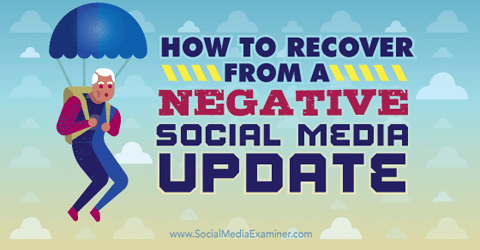How to Recover From a Negative Social Media Update

Has a team member ever posted something inappropriate from your social media account?
Are you ready with a recovery plan?
If someone wreaks havoc on your account, you need to be prepared for a worst-case scenario.
In this article you’ll discover how to recover from a bad post to your social media account.
#1: Determine Whether to Delete the Post
Whenever you discover a questionable post on your social media account, the first step in crisis management is to assess the situation. No matter the extent of your account hack or blunder, you will have to do some damage control. Just remember deleting the post will not make the entire situation go away.
Many tools make it easy for someone to grab a screenshot of your social indiscretion. If you, someone on your team or an agency you’ve hired to run your social media campaigns created the post, deleting it could make you look bad.
Plus, if it comes to light that you tried to sweep a bad situation under the rug, your brand will only look worse. That’s why it’s typically a better idea to let these posts stay, even if you later go on to regret them.
Lewd or Graphic Posts: It is unfair to subject your followers to images that make them feel uncomfortable, especially if your target audience is primarily composed of a younger demographic. If someone publishes wildly inappropriate (think R-rated and above) text or graphics to your account, delete the posts as quickly as possible.
Obvious Hacks: If it’s clear that your account has been hacked, there’s a higher level of acceptance in deleting the post. In this day and age it’s fair to assume people know that being “hacked” is just another cost associated with conducting business online.
Remember, people won’t always believe that you’ve been hacked. Plus, many social users are quick to call out a brand that they think faked a hack as a publicity stunt.
It’s also important to note that if your Twitter password is “password,” you’re not allowed to delete any hacked posts.
#2: Take Responsibility
When it comes to the apology message, there are typically two people who should send it: the person who made the mistake or someone higher up in the company.
Even if the offending post is due to a hack, apologize to your followers and fans.
While most of the time it sounds better when the person who sent the inappropriate social message takes responsibility, it’s not always an option. If that’s the case, have someone who is higher up in the organization respond.
This way your followers feel like you’re taking the situation seriously and the spokesperson can address how the company plans to ensure nothing similar happens in the future.
The Onion is notorious for their unapologetic brand of humor. However, when backlash over an inappropriate tweet backed them into a corner, they were forced to apologize to their fans.
The incident took place during the 2013 Oscars when they insulted the then 9-year-old Oscar nominee Quvenzhané Wallis. After a massive social uproar, the CEO stepped up to apologize.
#3: Track Mentions and Engage
Get ready. Your company’s social messages are about to skyrocket. Granted, this depends on the size of your social media following and the level of offensiveness of the gaffe. Yet even the smallest brands should be prepared.
Stay on top of posts and mentions by using a social media management tool like Topsy. These tools not only make it easy to respond to the influx of comments, tweets and page posts, many will also allow you to run social analytics that assess the damage done to your following.
Use a social media management tool to keep track of mentions and repercussions following your social crisis.
When you keep track of mentions, you can respond appropriately and in a timely manner. It could mean the difference between keeping customers and losing their business (and respect) for good.
#4: Develop a Post Approval Process for the Future
Once you’ve gotten a handle on your current predicament, put new processes in place to make sure nothing similar happens in the future (provided, of course, that you don’t get hacked). Even if you haven’t yet faced a social media crisis, take these steps to ensure you never do.
Create a social media editorial calendar. Since most editorial calendars have multiple users, this is a great system to put in place to double-check and approve posts, so nothing obscene or inappropriate makes it through to your social accounts. Also, when you plan far enough in advance, you have time to consider your posts for days, or even weeks, before you submit or schedule them.
Create a social media content calendar to plan your activity and prevent inappropriate posts in the future.
If you use a social media agency, schedule time to sit down with them. That way you can spell out exactly what you will and will not allow them to post.
Conclusion
Most companies don’t intend to offend people on social media, but sometimes it just happens. Rogue or disgruntled employees, hackers and trolls all have motives and means to destroy your social presence.
Whether your brand gets hacked or someone on your team makes a poor content choice, it’s important to know how to handle situations that could tarnish your brand’s social reputation. Deal with your social media crisis immediately and tactfully. Plus, have a process in place that will protect your company in the future.
Article originally sourced from: http://www.socialmediaexaminer.com/recover-from-a-negative-social-media-update/
Did you enjoy this article?
Get our news insights delivered directly to your inbox every month. No SPAM, we promise.
